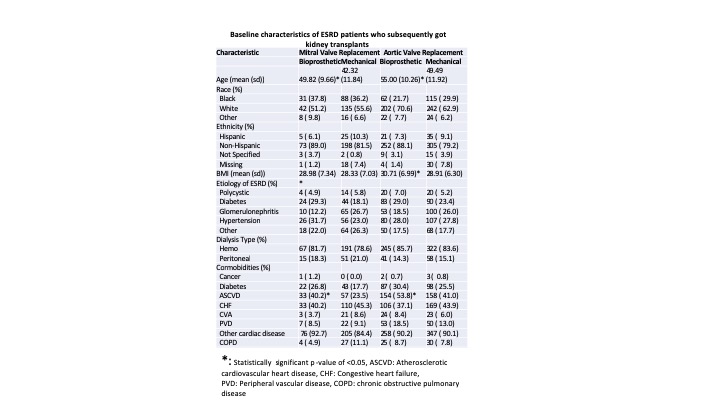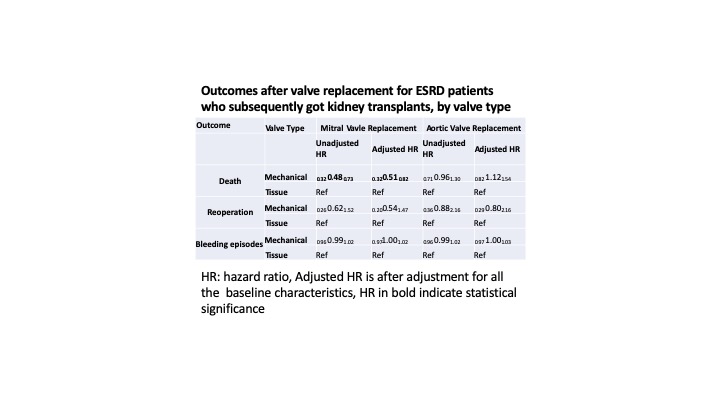Choice of Mitral Valve and Aortic Valve for Replacement for ESRD Patients Eligible for Kidney Transplant: A USRDS Analysis
N. Sarabu1, D. Ngendahimana2, L. Al Dahabre3, K. Lentine4, K. Chavin1, T. Srinivas1, S. Deo2
1University Hospitals Cleveland, Cleveland, OH, 2Case Western Reserve University, Cleveland, OH, 3University Hospitals of Cleveland, Cleveland, OH, 4Saint Louis University, Saint Louis, MO
Meeting: 2020 American Transplant Congress
Abstract number: B-045
Keywords: Heart, Kidney, Outcome, Valve replacement
Session Information
Session Name: Poster Session B: Kidney: Cardiovascular and Metabolic Complications
Session Type: Poster Session
Date: Saturday, May 30, 2020
Session Time: 3:15pm-4:00pm
 Presentation Time: 3:30pm-4:00pm
Presentation Time: 3:30pm-4:00pm
Location: Virtual
*Purpose: Tissue valve (TiV) may be preferred over mechanical valve (meV) in ESRD patients for valve replacement. Among ESRD patients who are kidney transplant eligible, it is unknown which valve type is better or worse.
*Methods: All adult ESRD patients who underwent TiV and meV for mitral valve replacement (MVR) or aortic valve replacement (AVR), between 1992 and 2015, and subsequently undergone KT were identified from the United States Renal Data System (USRDS) database with linked administrative claims. Since those who got transcatheter aortic valve replacement were low in number, they were excluded. Time to all-cause death, reoperation for repeat valve replacement, and major bleeding episodes requiring hospitalization were compared between tissue valve (TiV) and mechanical valve (MeV) separately for MVR and AVR, using Cox proportional hazards (adjusted hazards ratio, aHR) with KT status as a time-varying covariate.
*Results: There were a total of 325 (82 TiV, 243 MeV) and 671 (286 TiV, 385 MeV) ESRD patients that underwent MVR and AVR respectively, who subsequently received KT. Patients who had tissue valves were older and had more comorbidity burden (Figure 1). While TiV and MeV for AVR were comparable in terms of long term survival (aHR:0.821.121.54), time to reoperation (aHR: 0.290.802.16), and major bleeding episodes (aHR: 0.971.001.03), MeV was significantly better than TiV for MVR in terms of survival (aHR:0.320.510.82) but comparable on time to reoperation (aHR:0.200.541.47) and major bleeding episodes (aHR:0.971.001.02)(Figure 2).
*Conclusions: MeV is preferable over TiV for MVR but TiV may be preferable over MeV (to avoid anticoagulation) for AVR for ESRD patients eligible for KT.
To cite this abstract in AMA style:
Sarabu N, Ngendahimana D, Dahabre LAl, Lentine K, Chavin K, Srinivas T, Deo S. Choice of Mitral Valve and Aortic Valve for Replacement for ESRD Patients Eligible for Kidney Transplant: A USRDS Analysis [abstract]. Am J Transplant. 2020; 20 (suppl 3). https://atcmeetingabstracts.com/abstract/choice-of-mitral-valve-and-aortic-valve-for-replacement-for-esrd-patients-eligible-for-kidney-transplant-a-usrds-analysis/. Accessed June 30, 2025.« Back to 2020 American Transplant Congress


